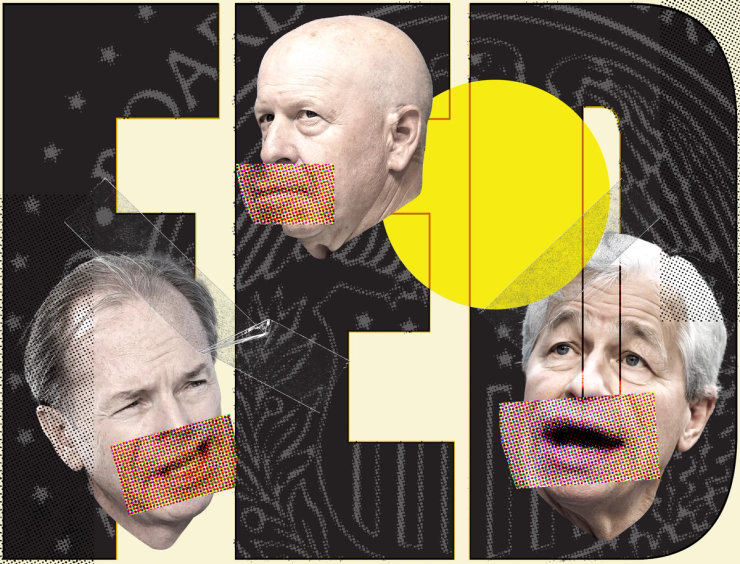The Scoop
Big banks have hired one of the country’s top trial lawyers and are preparing to sue the Federal Reserve — a nearly unthinkable challenge — if sweeping new industry regulations aren’t watered down.
Eugene Scalia, the son of the former Supreme Court justice and a well-known conservative litigator, is quietly drawing up a lawsuit seeking to block the proposed rules on behalf of the Bank Policy Institute, a trade group that represents JPMorgan, Citibank, Goldman Sachs, and others, people familiar with the matter said. It would be the first time in recent memory that the industry has sued the Fed, and a departure from standard halls-of-power persuasion efforts that try to avoid antagonizing its chief regulator.
The stakes are high: Banks warn they’ll pull back from lending, particularly to small businesses and borrowers with lower incomes or credit scores. Some of that is posturing, but the rules would eat into bank profits, pushing them in some lines of business below the returns they have promised shareholders.
In a full-court press against the proposed rules, banks have run ads during Washington Commanders football games and enlisted pension funds to put a more sympathetic face on their grievances. Testifying in front of Congress last month, the CEOs of the biggest banks criticized the proposal in a tone so confident it bordered on condescension. “It makes no sense,” said Morgan Stanley’s James Gorman, who stepped down last week.
In this article:
Know More
The rules, called Basel Endgame, are the result of more than a decade of efforts by global bank regulators to harmonize patchwork rules that had sprouted up over decades and were further balkanized in varying responses to the 2008 crisis. Michael Barr, the Fed’s top cop, says that even 15 years later, U.S. banks still aren’t prepared for a financial shock.
The government says banks would have to hold about 20% more capital — a buffer they’d build up by socking away profits that might otherwise go to shareholders, employees, or acquisitions. The banks say those numbers are off and have produced their own analysis that puts the add-on closer to 30%.
“As a matter of legal process, it’s not going to be enough to say that a bunch of regulators got together in Switzerland, and this rule is what they brought down from the mountain,” Scalia told Semafor.
“The agencies have to do their own work, explaining why these new requirements are properly calibrated, and why their benefits are worth the costs,” he said. “This proposal doesn’t do that.”
Even using the more conservative figures, a bank with $1 trillion of loans and trading assets in a mix similar to JPMorgan’s would need an extra $20 billion or so of capital, according to a Semafor analysis. Most of that comes from surcharges to mortgages, credit cards, and securities.
“Requiring more capital will almost always improve the stability of the banking system,” said Randy Quarles, the Fed’s chief bank supervisor during the Trump administration. “But it may not improve the stability of the financial system as a whole.” A lot of lending has already been pushed out of banks and into private investment firms, where the Fed has a harder time seeing it, he said.
The proposal has critics even within the government. Two members of the Fed’s board voted against it, as did two members of the FDIC’s board, one of whom said last week that he was “unable to defend or even understand important aspects.”
That leaves Fed Chair Jerome Powell as referee, and he has hinted both in dry government-speak in public and in more pointed comments in private meetings with congressional lawmakers that the proposal is likely to be reworked. He only has a few months to do so: The Fed generally doesn’t announce overhauls on the eve of a presidential election.
Liz’s view
Industry lobbying is nothing new, but this has a different tone. Banks simply do not sue the Fed, which has virtually unlimited ways to make Wall Street’s life difficult.
I’m sympathetic to some of their specific gripes. One rule rests on the bizarre notion that giant government pension funds are bad credit risks. Another would make it more expensive for banks to do clearly useful things, like helping airlines hedge their exposure to the price of jet fuel.
The rules also add escalating charges for “operational risk,” a catch-all for screwups (read: scandals). On the one hand, banks screw up a lot; just in 2020, Citigroup accidentally sent $900 million to the wrong person and couldn’t get it back. But the rules here essentially assume that the more revenue a bank has, the more likely it is to screw up, which seems like a crude way to tackle the “too big to manage” concern.
And finally, anything that’s been anywhere near a financial crisis in the past is treated punitively. Fine, but it’s fighting the last battle and exposes a gap between the kind of thing we want to encourage banks to do because it’s good for society, like making home loans in poor neighborhoods, and the kind of thing that often loses them money. As I wrote last spring, banks exist to take risks, and trying to squeeze those risks out turns them into mattresses.
I suspect this proposal ends up being significantly changed. Powell has sounded ambivalent about parts of it, and his overriding goal is building consensus among the officials who need to sign off on the final rule, and that will require some significant changes. The proposal has made strange bedfellows, too. Some climate activists are opposed to its treatment of renewable-energy loans.
The View From Europe
The proposal gives a boost to European banks, which have gotten their clocks cleaned on their home turf by American rivals. For example, in corporate lending, it goes lighter on bank loans (how European companies tend to finance themselves) than on bonds (an American specialty). European regulators estimate that the region’s banks would only need an extra €600 million of capital, versus more than $170 billion that the Fed figures U.S. lenders will need to add.
Notable
- Adding to their headwinds, the largest U.S. banks are expected to report a sharp rise in bad debt in tomorrow’s quarterly earnings reports. — Financial Times


